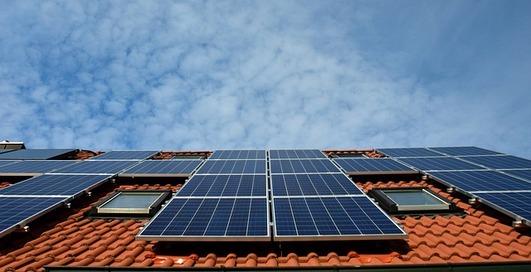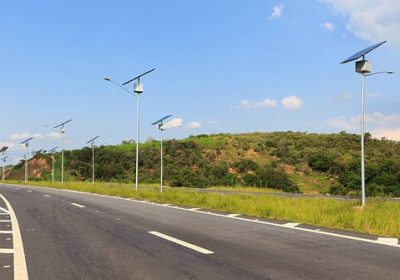Energy-Efficient Homes: Top Trends and Technologies for Reducing Your Carbon Footprint

The world is currently facing an unprecedented environmental crisis, and climate change is at the forefront of this crisis. One of the leading contributors to climate change is the excessive use of energy, which is primarily generated from fossil fuels. According to the U.S. Environmental Protection Agency, the residential sector accounts for 21% of total energy consumption in the United States. However, there are various ways in which homeowners can reduce their carbon footprint and contribute to the fight against climate change. One of these ways is by investing in energy-efficient homes. In this article, we will explore the top trends and technologies for reducing your carbon footprint.
Solar Power
Solar power is one of the most popular technologies for energy-efficient homes. Solar panels are installed on the roof of a home and convert sunlight into electricity. This electricity can be used to power appliances and other devices in the home. Additionally, excess energy can be stored in batteries for later use or fed back into the grid. Solar power is a great way to reduce carbon emissions, as it does not produce any greenhouse gases. Moreover, solar panels have become more affordable and efficient over the years, making it a viable option for homeowners.
Smart Home Technology
Smart home technology is another trend that is gaining popularity among homeowners. This technology allows homeowners to control various systems in their homes remotely, such as heating, cooling, lighting, and security. By using smart home technology, homeowners can optimize energy usage, thereby reducing their carbon footprint. For instance, smart thermostats can automatically adjust the temperature in a home based on occupancy and time of day, ensuring that energy is not wasted when it is not needed. Similarly, smart lighting systems can be programmed to turn off when no one is in the room, reducing energy usage.
Energy-Efficient Windows
Windows are an essential part of any home, but they can also be a significant source of energy loss. Energy-efficient windows are designed to minimize energy loss, thereby reducing heating and cooling costs. These windows are typically double or triple-glazed, with a low-emissivity coating that reflects heat back into the home. Energy-efficient windows can also reduce noise pollution and improve indoor comfort levels.
Insulation
Insulation is another critical factor in energy-efficient homes. It is designed to prevent heat loss during the winter and heat gain during the summer, thereby reducing the need for heating and cooling systems. Insulation can be installed in various areas of a home, such as walls, attics, and floors. There are several types of insulation materials available, such as fiberglass, cellulose, and foam, each with its own benefits and drawbacks.
Energy-Efficient Appliances
Household appliances such as refrigerators, washing machines, and dishwashers can consume a significant amount of energy. Energy-efficient appliances are designed to reduce energy consumption, thereby lowering electricity bills and reducing carbon emissions. When purchasing appliances, look for the Energy Star label, which indicates that the appliance meets strict energy efficiency guidelines set by the U.S. Environmental Protection Agency.
Green Roofs
Green roofs are an innovative technology that is gaining popularity among homeowners. They are essentially a layer of vegetation planted on top of a building, providing numerous benefits such as reduced heat absorption, improved air quality, and reduced stormwater runoff. Green roofs can also act as a natural insulation layer, reducing energy consumption.
Geothermal Heating and Cooling Systems
Geothermal heating and cooling systems are becoming increasingly popular among homeowners who are looking to reduce their carbon footprint. These systems work by utilizing the constant temperature of the earth to heat and cool a home. A geothermal system consists of a heat pump, which is connected to a series of underground pipes filled with a water solution. The solution absorbs heat from the earth during the winter and releases heat back into the earth during the summer, providing heating and cooling for a home. Geothermal systems are highly efficient and can reduce energy consumption by up to 50%, making them a cost-effective and environmentally friendly alternative to traditional heating and cooling systems.
Passive House Design
Passive house design is a concept that is gaining popularity among architects and homeowners. This design approach focuses on creating homes that are highly energy-efficient and do not rely on traditional heating and cooling systems. Passive houses are designed to be airtight and well-insulated, with windows and doors strategically placed to maximize natural light and ventilation. The result is a home that requires very little energy to maintain a comfortable indoor temperature, reducing the homeowner’s carbon footprint significantly.
Energy Monitoring Systems
Energy monitoring systems are becoming increasingly popular among homeowners who want to track their energy usage and identify areas for improvement. These systems are typically installed in a home’s electrical panel and provide real-time data on energy consumption. By monitoring their energy usage, homeowners can identify areas where energy is being wasted and take steps to reduce their carbon footprint. Some energy monitoring systems also allow homeowners to track solar panel performance, providing valuable data on the effectiveness of their solar power system.
Moreover, energy-efficient homes not only help the environment but can also provide financial benefits for homeowners. By reducing energy consumption, homeowners can save money on their utility bills, which can add up to significant savings over time. Additionally, energy-efficient homes can increase a home’s value, making it more attractive to potential buyers.
It is essential to note that energy-efficient homes are not a one-size-fits-all solution. The most effective energy-efficient strategies for a particular home will depend on various factors such as location, climate, and the homeowner’s lifestyle. Therefore, it is essential to consult with experts such as architects, builders, and energy consultants to determine the best energy-efficient strategies for your home.
In addition, government incentives and rebates are available for homeowners who invest in energy-efficient homes. For instance, the federal government provides tax credits for homeowners who install solar panels, geothermal heating and cooling systems, and energy-efficient windows and doors. Local governments and utility companies also offer incentives such as rebates and low-interest loans for homeowners who invest in energy-efficient homes.
Finally, it is crucial to recognize that energy-efficient homes are not the sole solution to climate change. While reducing carbon emissions from residential homes is crucial, it is also essential to address other sources of greenhouse gas emissions such as transportation, industry, and agriculture. Therefore, homeowners can also contribute to the fight against climate change by reducing their carbon footprint in other areas such as reducing car usage, choosing sustainable food options, and supporting sustainable businesses.
It is worth mentioning that energy-efficient homes not only benefit the environment and homeowners’ wallets but also improve the occupants’ health and well-being. For instance, indoor air quality can significantly impact residents’ health, especially those with respiratory issues. A well-insulated and properly ventilated home can help reduce pollutants, such as mold, dust, and allergens, improving the air quality and overall health of occupants.
Furthermore, energy-efficient homes can provide a more comfortable living environment by reducing temperature fluctuations, improving indoor air quality, and increasing natural light. This can lead to improved mental and physical well-being for occupants, ultimately resulting in a better quality of life.
Overall, energy-efficient homes are a win-win solution for the environment, homeowners, and occupants’ health and well-being. By investing in energy-efficient technologies and strategies, homeowners can reduce their carbon footprint, save money on utility bills, and improve their quality of life. It is essential to recognize that making homes energy-efficient is not a one-time investment but a continuous effort that requires homeowners to adopt sustainable behaviors such as reducing energy usage, properly maintaining energy-efficient appliances, and conserving water.
In addition, it is essential to recognize the role of businesses and policymakers in promoting energy-efficient homes. Businesses can contribute by producing and selling energy-efficient products and materials, promoting sustainable behaviors, and investing in renewable energy sources. Policymakers can provide incentives and regulations that encourage homeowners to invest in energy-efficient homes, such as tax credits, building codes, and energy efficiency standards.
For example, some cities and states have implemented building codes that require new homes to meet specific energy efficiency standards. In California, all new homes are required to have solar panels, making it the first state to mandate solar power for new homes. This regulation aims to reduce carbon emissions and encourage homeowners to invest in renewable energy sources.
Furthermore, policymakers can provide funding for research and development of new energy-efficient technologies and strategies, as well as support sustainable energy initiatives at the local and national level. This can create a more favorable environment for businesses to invest in renewable energy and energy-efficient products, ultimately benefiting homeowners and the environment.
Conclusion
In conclusion, energy-efficient homes are becoming increasingly popular among homeowners who are looking to reduce their carbon footprint and contribute to the fight against climate change. By investing in solar power, smart home technology, energy-efficient windows, insulation, energy-efficient appliances, green roofs, geothermal heating and cooling systems, passive house design, and energy monitoring systems, homeowners can significantly reduce their energy consumption and carbon emissions. With the cost of these technologies becoming more affordable, it is now more accessible than ever for homeowners to make their homes more energy-efficient and contribute to a greener future.









